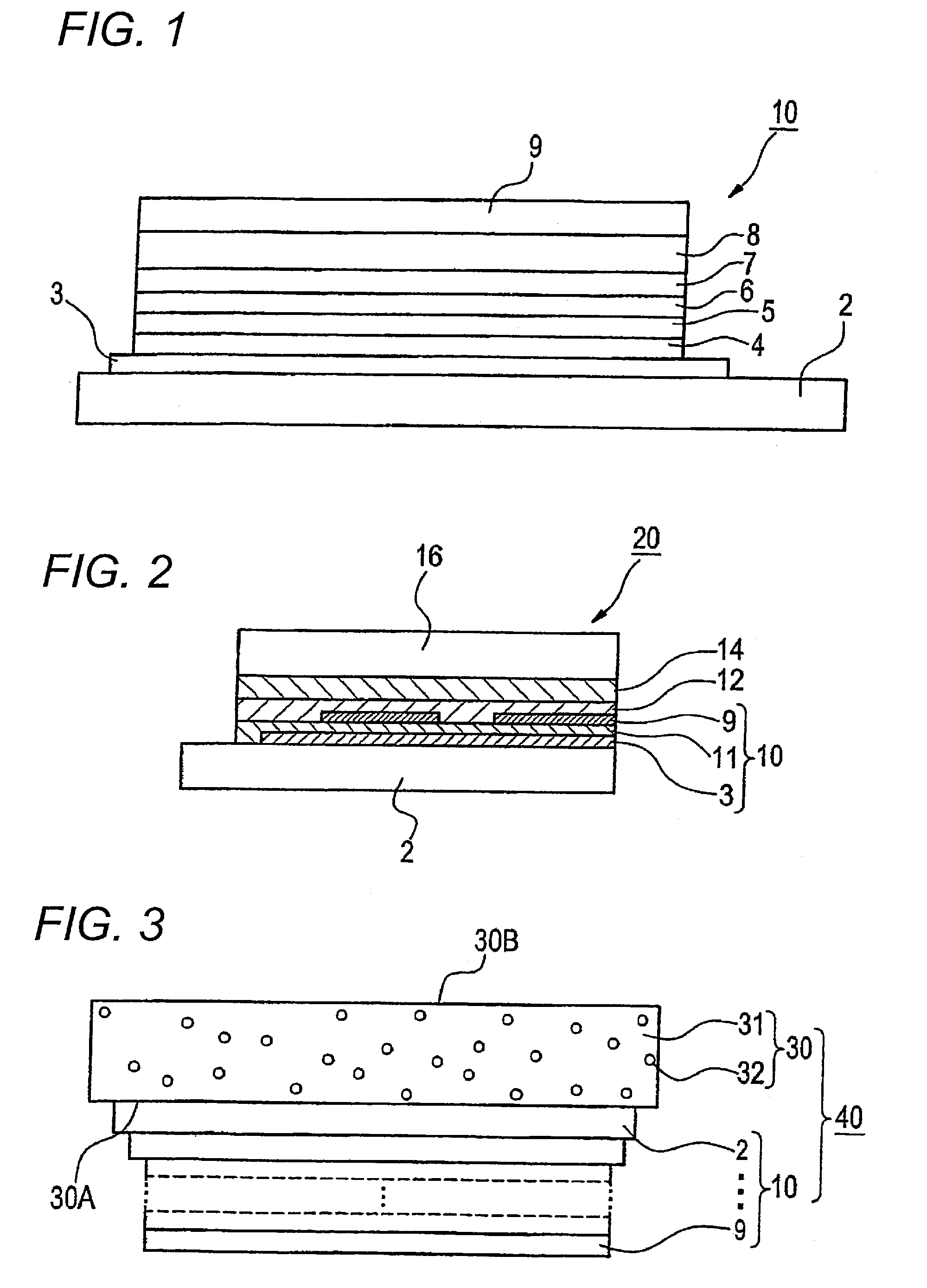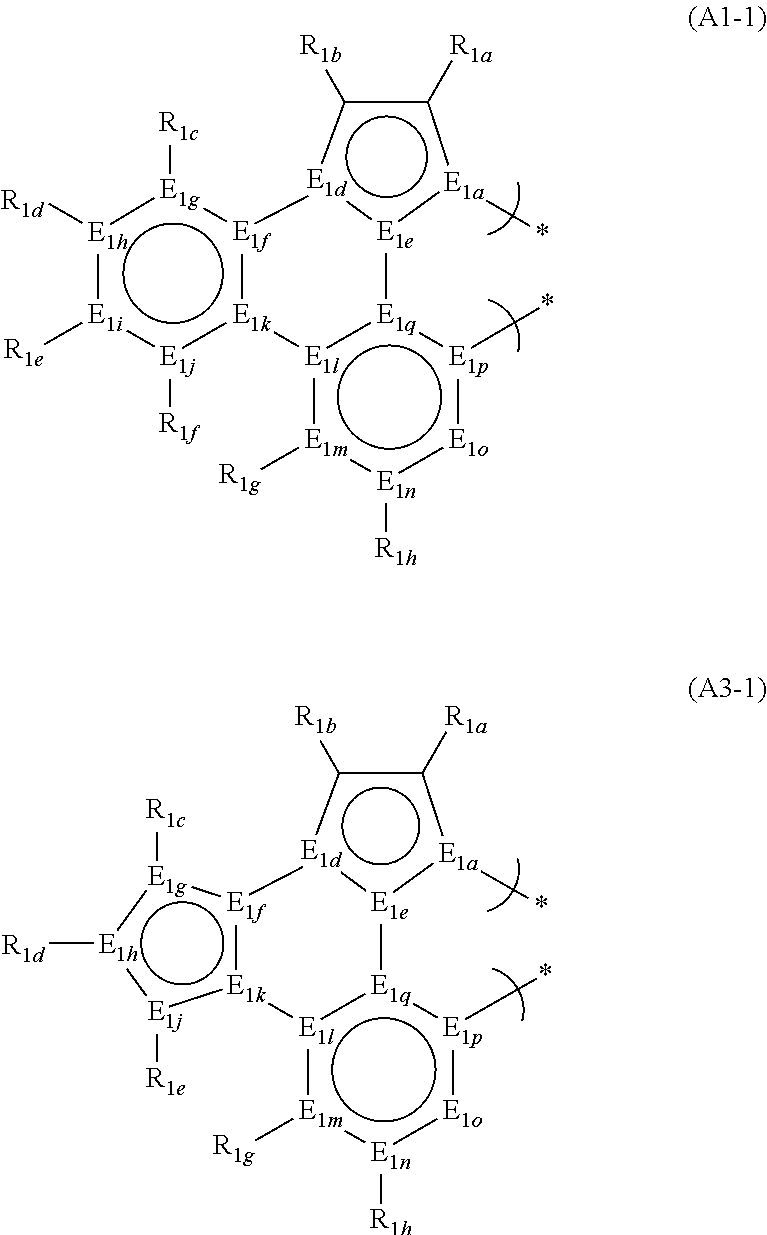Material for organic electroluminescence device and organic electroluminescence device
a technology of electroluminescence device and material, which is applied in the direction of thermoelectric devices, discharge tube luminescnet screens, natural mineral layered products, etc., can solve the problems of low luminous efficiency and achieve the effects of reducing durability, low luminous efficiency and improving luminous efficiency
- Summary
- Abstract
- Description
- Claims
- Application Information
AI Technical Summary
Benefits of technology
Problems solved by technology
Method used
Image
Examples
example 1
[0322]An indium tin oxide (ITO) film-provided glass substrate having a thickness of 100 μm and a size of 2.5 cm in square (manufactured by Geomatec Co., Ltd., surface resistance: 10Ω / □) was put in a washing vessel, ultrasonically washed in 2-propanol and then subjected to a UV-ozone treatment for 30 minutes. The following organic layers were successively vapor deposited on this transparent anode (ITO film) by means of vacuum vapor deposition.
[0323]First layer: CuPc (copper phthalocyanine), film thickness: 120 nm
[0324]Second layer: NPD (N,N′-di-α-naphthyl-N,N′-diphenyl)-benzidine), film thickness: 7 nm
[0325]Third layer: CBP (4,4′-di(9-carbazoyl)biphenyl), film thickness: 3 nm
[0326]Fourth layer (light emitting layer): Dopant (9% by mass), host material (91% by mass), film thickness: 30 nm
[0327]Fifth layer: First electron transport material (BAlq), film thickness: 30 nm
[0328]1 nm-thick lithium fluoride and 100 nm-thick metallic aluminum were vapor deposited in this order thereon, there...
example 2
[0337]With respect to each of the compounds of the invention and the comparative compounds, a TG curve at 1×10−2 Pa was measured in a sample amount of 20 mg, and a temperature (T(−5%)) at a [(weight loss percent)−5%] point (since all of purities of the samples are 97% or more in terms of an HPLC area ratio, the −5% point was regarded as a temperature at which sublimation and evaporation were started) and a temperature (T(end)) at a point where the weight loss was completed were measured. In this respect, all of the measurements are carried out while elevating the temperature at a rate of 1° C. per minute. Also, sublimation purification was carried out at the temperature T(end) in a starting weight of 500 mg under the same pressure, and a purification yield thereof was evaluated. Also, a graph plotting a relation between a fluorine atom content and a sublimation aptitude (ΔT) is shown in FIG. 5.
[0338]Next, a device having the following constitution was prepared using the obtained mat...
example 3
[0349]An indium tin oxide (ITO) film-provided glass substrate having a thickness of 100 μm and a size of 2.5 cm in square (manufactured by Geomatec Co., Ltd., surface resistance: 10Ω / □) was put in a washing vessel, ultrasonically washed in 2-propanol and then subjected to a UV-ozone treatment for 30 minutes. The following organic layers were successively vapor deposited on this transparent anode (ITO film) by means of vacuum vapor deposition.
[0350]First layer: CuPc (copper phthalocyanine), film thickness: 120 nm
[0351]Second layer: NPD (N,N′-di-α-naphthyl-N,N′-diphenyl)-benzidine), film thickness: 7 nm
[0352]Third layer: Charge transport material, film thickness: 2 nm
[0353]Fourth layer (light emitting layer): Dopant (12% by mass), host material (88% by mass), film thickness: 30 nm
[0354]Fifth layer: First electron transport material (BAlq), film thickness: 30 nm
[0355]1 nm-thick lithium fluoride and 100 nm-thick metallic aluminum were vapor deposited in this order thereon, thereby formi...
PUM
| Property | Measurement | Unit |
|---|---|---|
| thickness | aaaaa | aaaaa |
| thickness | aaaaa | aaaaa |
| thickness | aaaaa | aaaaa |
Abstract
Description
Claims
Application Information
 Login to View More
Login to View More - R&D
- Intellectual Property
- Life Sciences
- Materials
- Tech Scout
- Unparalleled Data Quality
- Higher Quality Content
- 60% Fewer Hallucinations
Browse by: Latest US Patents, China's latest patents, Technical Efficacy Thesaurus, Application Domain, Technology Topic, Popular Technical Reports.
© 2025 PatSnap. All rights reserved.Legal|Privacy policy|Modern Slavery Act Transparency Statement|Sitemap|About US| Contact US: help@patsnap.com



